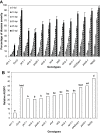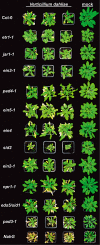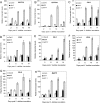Ethylene perception via ETR1 is required in Arabidopsis infection by Verticillium dahliae
- PMID: 20447269
- PMCID: PMC6640466
- DOI: 10.1111/j.1364-3703.2009.00592.x
Ethylene perception via ETR1 is required in Arabidopsis infection by Verticillium dahliae
Abstract
Vascular wilts caused by Verticillium spp. are very difficult to control and, as a result, are the cause of severe yield losses in a wide range of economically important crops. The responses of Arabidopsis thaliana mutant plants impaired in known pathogen response pathways were used to explore the components in defence against Verticillium dahliae. Analysis of the mutant responses revealed enhanced resistance in etr1-1[ethylene (ET) receptor mutant] plants, but not in salicylic acid-, jasmonic acid- or other ET-deficient mutants, indicating a crucial role of ETR1 in defence against this pathogen. Quantitative polymerase chain reaction analysis revealed that the decrease in symptom severity shown in etr1-1 plants was associated with significant reductions in the growth of the pathogen in the vascular tissues of the plants, suggesting that impaired perception of ET via ETR1 results in increased disease resistance. Furthermore, the activation and increased accumulation of the PR-1, PR-2, PR-5, GSTF12, GSTU16, CHI-1, CHI-2 and Myb75 genes, observed in etr1-1 plants after V. dahliae inoculation, indicate that the outcome of the induced defence response of etr1-1 plants seems to be dependent on a set of defence genes activated on pathogen attack.
Figures




Similar articles
-
ERECTA, salicylic acid, abscisic acid, and jasmonic acid modulate quantitative disease resistance of Arabidopsis thaliana to Verticillium longisporum.BMC Plant Biol. 2014 Apr 1;14:85. doi: 10.1186/1471-2229-14-85. BMC Plant Biol. 2014. PMID: 24690463 Free PMC article.
-
Early responses in the Arabidopsis-Verticillium longisporum pathosystem are dependent on NDR1, JA- and ET-associated signals via cytosolic NPR1 and RFO1.Mol Plant Microbe Interact. 2006 Sep;19(9):958-69. doi: 10.1094/MPMI-19-0958. Mol Plant Microbe Interact. 2006. PMID: 16941900
-
The Arabidopsis hrl1 mutation reveals novel overlapping roles for salicylic acid, jasmonic acid and ethylene signalling in cell death and defence against pathogens.Plant J. 2002 May;30(4):467-80. doi: 10.1046/j.1365-313x.2002.01300.x. Plant J. 2002. PMID: 12028576
-
Identification of a locus controlling Verticillium disease symptom response in Arabidopsis thaliana.Plant J. 2003 Sep;35(5):574-87. doi: 10.1046/j.1365-313x.2003.01830.x. Plant J. 2003. PMID: 12940951
-
Ethylene and jasmonic acid signaling affect the NPR1-independent expression of defense genes without impacting resistance to Pseudomonas syringae and Peronospora parasitica in the Arabidopsis ssi1 mutant.Mol Plant Microbe Interact. 2003 Jul;16(7):588-99. doi: 10.1094/MPMI.2003.16.7.588. Mol Plant Microbe Interact. 2003. PMID: 12848424
Cited by
-
Regulation of Botrytis cinerea Infection and Gene Expression in Cut Roses by Using Nano Silver and Salicylic Acid.Plants (Basel). 2021 Jun 18;10(6):1241. doi: 10.3390/plants10061241. Plants (Basel). 2021. PMID: 34207351 Free PMC article.
-
iTRAQ-based proteomics analysis of autophagy-mediated immune responses against the vascular fungal pathogen Verticillium dahliae in Arabidopsis.Autophagy. 2018;14(4):598-618. doi: 10.1080/15548627.2017.1423438. Epub 2018 Feb 21. Autophagy. 2018. PMID: 29369001 Free PMC article.
-
ERECTA, salicylic acid, abscisic acid, and jasmonic acid modulate quantitative disease resistance of Arabidopsis thaliana to Verticillium longisporum.BMC Plant Biol. 2014 Apr 1;14:85. doi: 10.1186/1471-2229-14-85. BMC Plant Biol. 2014. PMID: 24690463 Free PMC article.
-
De novo assembly and discovery of genes involved in the response of Solanum sisymbriifolium to Verticillium dahlia.Physiol Mol Biol Plants. 2019 Jul;25(4):1009-1027. doi: 10.1007/s12298-019-00666-4. Epub 2019 May 13. Physiol Mol Biol Plants. 2019. PMID: 31402823 Free PMC article.
-
A Case of Plant Vaccination: Enhancement of Plant Immunity against Verticillium dahliae by Necrotized Spores of the Pathogen.Plants (Basel). 2022 Jun 26;11(13):1691. doi: 10.3390/plants11131691. Plants (Basel). 2022. PMID: 35807643 Free PMC article.
References
-
- Abad, L.R. , D'Urzo, M.P. , Liu, D. , Narasimhan, M.L. , Reuveni, M. , Zhu, J.K. , Niu, X. , Singh, N.K. , Hasegawa, P.M. and Bressan, R. (1996) Antifungal activity of tobacco osmotin has specificity and involves plasma membrane permeabilization. Plant Sci. 118, 11–23.
-
- Alexander, D. , Goodman, R.M. , Gut‐Rella, M. , Glascock, C. , Weymann, K. , Friedrich, L. , Maddox, D. , Ahl‐Goy, P. , Luntz, T. , Ward, E. and Ryals, J. (1993) Increased tolerance to two oomycete pathogens in transgenic tobacco expressing pathogenesis‐related protein 1a. Proc. Natl. Acad. Sci. USA, 90, 7327–7331. - PMC - PubMed
-
- Beckman, C.H. (1987) The Nature of Wilt Diseases of Plants. St. Paul, MN: The American Phytopathological Society.
-
- Beckman, C.H. and Talboys, P.W. (1981) Anatomy of resistance In: Fungal Wilt Disease of Plants (Mace M.E., Bell A.A. and Beckman C.H., eds), pp. 431–486. New York: Academic Press.
-
- Bent, A.F. , Innes, R.W. , Ecker, J.R. and Staskawicz, B.J. (1992) Disease development in ethylene‐insensitive Arabidopsis thaliana infected with virulent and avirulent Pseudomonas and Xanthomonas pathogens. Mol. Plant–Microbe Interact. 5, 372–378. - PubMed
Publication types
MeSH terms
Substances
LinkOut - more resources
Full Text Sources
Molecular Biology Databases
Research Materials
Miscellaneous

